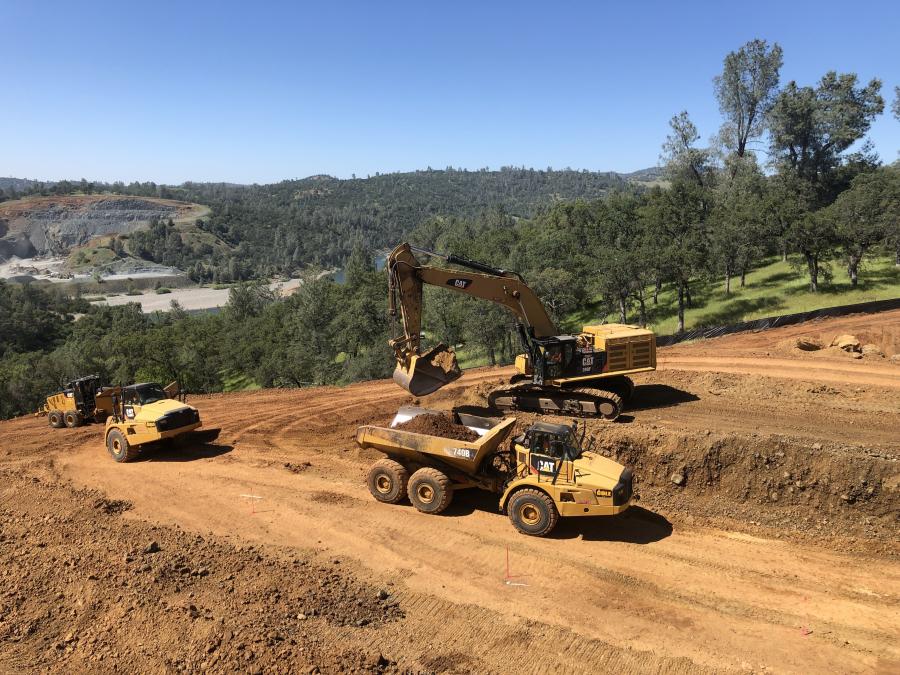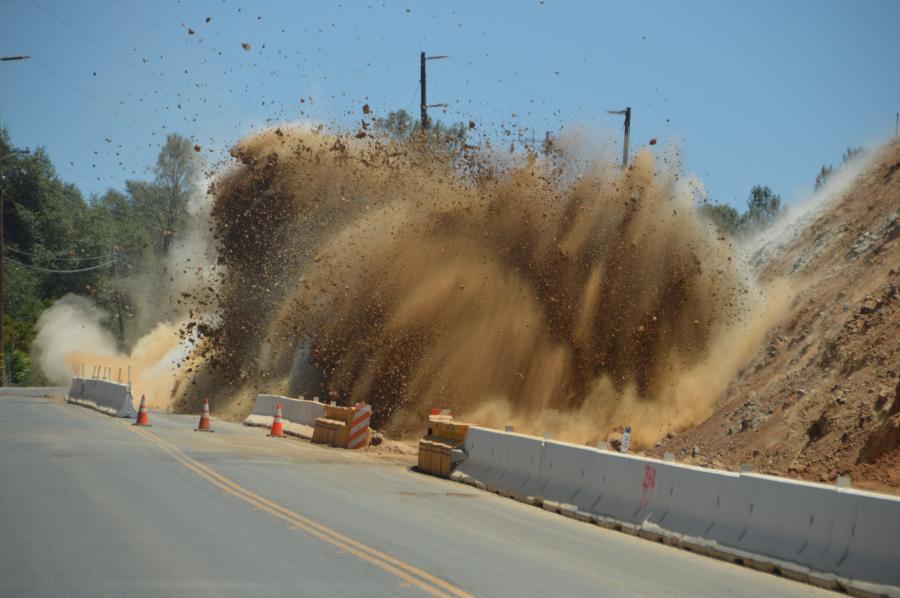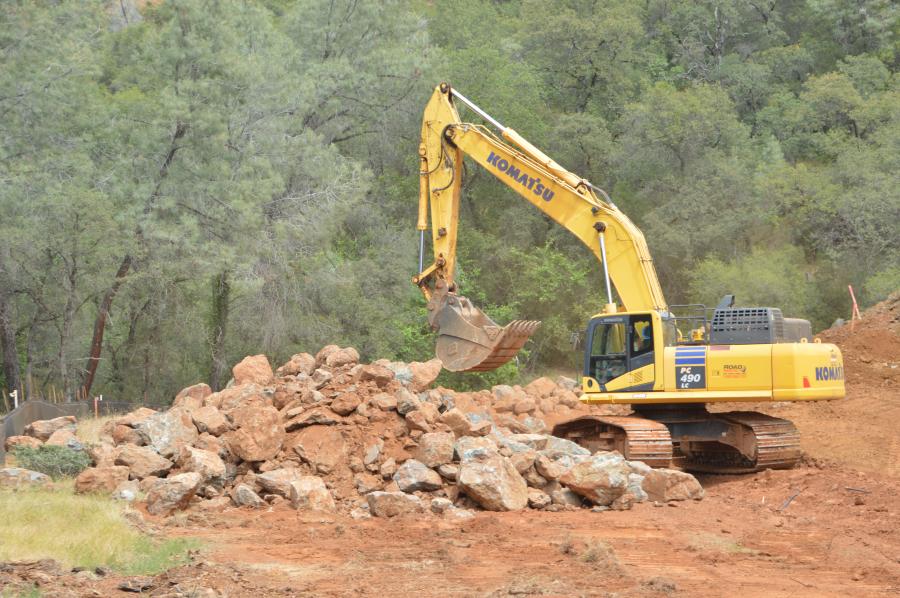Crews from Flatiron are upgrading a 2-mi. section of SR 20 from the Yuba River Bridge to approximately 1/3-mi. east of Smartsville Road, widening segments of highway to create uniform 12-ft. wide lanes and shoulders to a standard 8-ft. width and constructing a new bridge.
Flatiron crews are making significant progress on the $54 million State Route 20 Timbuctoo Roadway Project taking place a half-mile east of the Yuba River in eastern Yuba County, Calif.
The project, financed by state and federal dollars, began last February, with delivery anticipated in September 2021. Flatiron is ahead of schedule with a projected winter 2021 final construction.
The initiative is upgrading a 2-mi. section of SR 20 from the Yuba River Bridge to approximately 1/3-mi. east of Smartsville Road, as well as straightening curves on a section of the highway, widening segments of highway to create uniform 12-ft. wide lanes and shoulders to a standard 8-ft. width, constructing a new bridge on the realigned section of highway and increasing sight distances for motorists traveling on the highway.
In essence, the current two-lane highway, in an isolated hilly area with forests on either side and power lines and electrical infrastructure on both sides, is being widened by one lane in each direction with shoulders and intermittent passing lanes.
"The primary challenge was the topography and site geology," said Resident Engineer Aaron Chamberlin. "Large amounts of hard rock were encountered that required controlled blasting to be conducted. The design and construction needed to balance the roadway geometrics with environmental, land use and physical constraints. Roadways are designed with a 50-year life, structures are built for 100 plus year life. The construction is one of the first in the state to heavily utilize unmanned aerial systems [UAS] for the inspection and measurements of earthwork. The structure design is a standard cast-in-place box girder structure. This design minimizes construction costs and maintenance over the life of the structure."
Project Challenges
Flatiron's Project Manager, Charles Marrow, indicated that crews encountered challenges when it came to the rough terrain.
"We didn't get back onto the grade until mid-April, once the weather cleared up a little bit," said Marrow. "The clearing operation had challenges due to the hilly undulating terrain that is a signature of this region.
"The biggest challenges on this job were the rock excavation and of understanding how much rock blasting we would have," added Marrow, "and also being able to accommodate that work and schedule impact, because that was done by Edick & Watt, a subcontractor. We had to coordinate that with our dirt moving operation. It's kind of a dance – we can't blast as fast as you can move the material and so we had to pick and choose when and where they would blast. It's a very expensive operation moving the dirt/rock – $40,000 to $50,000 a day. Any day that you lose can hurt your project's bottom line, so we performed some additional rock blasting quantity investigations beyond what Caltrans provided us as far as rock and seismic refraction tests.
"We paid our blaster on a force account basis to do some test holes to determine where the metamorphic greenstone rock was and at what elevation," Marrow continued. "This let us know where the rock is and how much no-rock laden dirt we could move. We built our schedule on this information. There's a metamorphic formation in the Smartsville area, right next to the Yuba River Bridge, and there's a quarry across the river from us – the Nordic Quarry. The rock is very hard, some at as much as 30,000 psi."
The rock can be tough on the equipment.
"You can blast it, but you still have to deal with large boulders and we went through tons of ripping teeth and breaker tips," said Marrow. "It's a rough job and you have to make sure that you take excessive equipment wear and tear in your estimation process."
The drill team – Hillside Drilling Inc. – used a hammer and steel drill rig with a down-hole hammer clusterhead-type of drill that is designed for drilling through very hard rock at the bridge site.
"The clusterhead drill really did the trick when it was running well," said Marrow. "It was very tough drilling and there were mechanical issues. They used the right piece of equipment, but it was just very finicky."
Equipment
For the rock blasting, the subcontractor brought in four Ingersoll Rand ECMs – air track drill rigs — and Flatiron used Cat D10 and D8 dozers, Cat 390 and 345 excavators and Cat 825 compactors, along with a Cat 14 blade for haul road maintenance for the earth work, as well as Cat 740B articulated trucks. The project was not able to utilize scrapers due to rocky conditions.
Approximately 280,000 cu yds. were removed, with approximately one-third of that quantity requiring blasting. All of the material has been utilized on-site for the embankment construction.
"When we dug out a section of a hill, we had to move the soil to the most efficient location to build a fill area in which the new highway is placed on," said Marrow. "This project is designed to be a balanced job and we connected all the dots. Caltrans, when they design and build highways and freeways, always strives for that because the taxpayer benefits by having more efficient construction."
Building the cast-in-place concrete box girder bridge that is tall and has equally tall falsework, is no easy task.
"It's in a section of the project with very hilly and steep ravines," said Marrow. "Our strategy was to spend money and direct efforts upfront and create some good access for the bridge site. A lot of the other contractors that bid this job planned on using driven pile, because traditionally that is what you do when building falsework in a ravine and don't have the luxury of building it on a pad. As we were self-performing the dirt work, we also created our own access to bridge the construction site, which has allowed us to build it more efficiently."
The bridge is 800 ft. long and 60 ft. wide, with one lane in each direction, with an additional passing lane in the East uphill direction.
Bridge construction began in early May with 96-in. diameter cast-in driven holes (CIDH), some shafts being as deep as 90 ft. and others as shallow as 30 ft.
"That operation wrapped up at the end of June and in July we started building the substructure and columns and we're now working on the falsework and soffits for the superstructure," said Marrow. "So far it's going really well."
Sitech automated guidance systems (AMG) were placed on some of the dirt moving equipment. This AMG technology allows an operator to perform the equipment operation, but also the grade control all at the same time.
"We developed a site model and outfitted certain pieces of equipment with survey heads on the blades, which allowed us use fewer survey people on the grade," said Marrow. "This eliminated the safety issue of having personnel moving out and around equipment, and also reduces our costs because now you don't have to carry additional grade setters."
In addition to earth work, Flatiron started all the permanent road work.
"We're still not done with it, but are very glad that we started it when we did," said Marrow, who noted that early on, Flatiron knew that PG&E had to relocate some power lines and AT&T some communications lines. "They didn't end up impacting us, but it was something that was a little too close for comfort. PG&E had some poles in the way of the new highway and they had to move. About two or three weeks ago we achieved a majority of the hot mix paving. Nearly half of the eastern side of the paving has been finalized — we're going to do a final striping and install all final bells and whistles soon."
Drainage upgrades are an important part of the work for the stretch of highway in which some components were last updated in 1939.
"There might have been drainage system improvement over the years, but a lot of this old corrugated metal pipe gets corroded over the years," said Marrow, "so when you do a project like this, you always want to upgrade or replace systems because you're changing the hydrology of the highway and the hills. Here we have about 40 drainage systems that have to be upgraded or replaced."
Another challenge is to meet the many benchmarks before the end of 2020 as possible.
"We know the weather in the foothills does not always agree with construction work," said Marrow. "It was quite a push on our part – a lot of long hours and work on Saturdays, the schedule we gave ourselves was aggressive and the efforts of the rock investigators helped. We had some good luck, but it's also because of the execution of team out here – we were able to set those high goals and hit them."
Marrow also appreciates the efforts of the Caltrans team assigned to the project.
"We always try to ensure we develop a trusting relationship with the owner because it pays dividends and lets us know we can bring any issues to them," he said. "A project is a collaborative effort and shouldn't be an adversarial relationship, which many projects often are."
While the work site is somewhat isolated, it is only about an hour's drive at most for Marrow and the crews from the Sacramento Region. The ample work space is also appreciated as nearly all of the new alignment is below the existing highway and away from traffic.
Assisting Marrow are Civil Superintendent Fred Cargile, Bridge Foundation and Substructure Superintendent Jim Deatherage, Bridge Superstructure Superintendent Andrew Crenshaw and Steve Roberts, the general foreman of the dirt crew.
"Fred was the vision and driving force for the dirt work, and he and Steve were a great pair," said Marrow. "It's a great team with lots of experience and knowledge. The crews have good morale and gel well. Steve and Fred provided excellent leadership, which kept everybody moving towards one common goal, and that's the same for bridge crews."
Peak days have had approximately 55 people on-site, with the main subcontractors being Hillside Drilling Inc. for the CIDH piles; Pacific Steel Group for reinforcement install; Green Vista for temporary and permanent erosion control; Teichert Construction Inc. for HMA paving; Nevada Barricade and Sign Co. for metal beam guardrail installation; and Roll ‘N Rock Construction for traffic control.
When done, new materials should include 10,000 tons of concrete, 25,000 tons of asphalt and 643 tons of reinforcing steel.
Equipment on-site also includes: a Manitowoc 4000W and a Grove 90-ton cranes; Cat 390F and Komatsu PC490 LC excavators; a Cat 966 loader; a Cat 825 compactor; and various 4,000 –gal. water trucks.
Most of the equipment that Flatiron is using is rented.
"If a piece of equipment goes down, we make a call. For a simple fix, it could be repaired within hours and if it's a more complicated fix, it might take a shift or more," said Marrow, "But our vendors are very responsive and it's good business to take care of your customers."
Equipment is being rented from Holt of California Rentals; Cresco Equipment Rentals; Road Machinery & Supplies Co.; California Compaction Company; and JP Equipment Rentals.
"We have our divisional office in Benicia and they have a team of individuals that source the equipment, set up agreements and coordinate any repairs or transferring of equipment," said Marrow. "They are our first line and they create relationships with these companies, as do we."
In terms of lessons learned from this project, Marrow gained a greater appreciation for automated machine guidance systems and new technologies, such as survey equipment.
"It's an up-front initial investment, but it paid off," he said, "as did the rock investigations. We knew it was going to be a risk, but I didn't realize how much it would pay off until we started getting into it and had that confidence knowing it wasn't some unknown. You always want to make sure you have a good plan."
Highway Background
"The roadway no longer meets current 55-mph highway design standards and the existing alignment and shoulder widths no longer meet current highway design standards," said Gilbert Mohtes-Chan, Caltrans public information officer of District 3. "We will have standard shoulders and lanes. Statistics indicated that many of the crashes involved vehicles running off the roadway. We are straightening the windy curves. The new bridge is part of a new alignment that will feature more gentle curves"
It also will have improved sightlines around curves, improved storm water drainage systems, and updated safety barrier systems. The bridge construction also allows for wildlife to remain protected from the traveling public, while maintaining the current ecosystem at the bridge construction location.
The project will be able to handle 8,000 cars and 600 trucks daily. The new infrastructure was designed by Caltrans.
Caltrans has provided Flatiron with right-of-way areas to store materials and equipment and set up offices and laydown yards. Due to the nature of the work, which includes blasting large amounts of rock, traffic is temporarily halted and restricted to one lane to allow crews to perform any highway clean-up from a blast. Motorists also have been advised to take detours to avoid the work zone to minimize impacts to the traveling public.
"We have an extensive outreach campaign to alert motorists to expect up to 40-minute traffic delays through the Timbuctoo project and a nearby Browns Valley construction project west of the Yuba River," said Mohtes-Chan. "The rock blasting operations earlier this spring went smoothly with few extended delays to traffic. We anticipate the bulk of the roadwork to be completed this fall. The major work next season will involve the bridge construction." CEG
Irwin Rapoport
A journalist who started his career at a weekly community newspaper, Irwin Rapoport has written about construction and architecture for more than 15 years, as well as a variety of other subjects, such as recycling, environmental issues, business supply chains, property development, pulp and paper, agriculture, solar power and energy, and education. Getting the story right and illustrating the hard work and professionalism that goes into completing road, bridge, and building projects is important to him. A key element of his construction articles is to provide readers with an opportunity to see how general contractors and departments of transportation complete their projects and address challenges so that lessons learned can be shared with a wider audience.
Rapoport has a BA in History and a Minor in Political Science from Concordia University. His hobbies include hiking, birding, cycling, reading, going to concerts and plays, hanging out with friends and family, and architecture. He is keen to one day write an MA thesis on military and economic planning by the Great Powers prior to the start of the First World War.
Read more from Irwin Rapoport here.
Today's top stories















